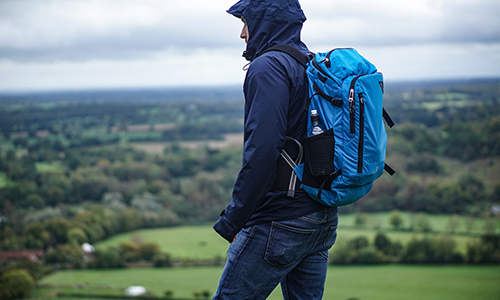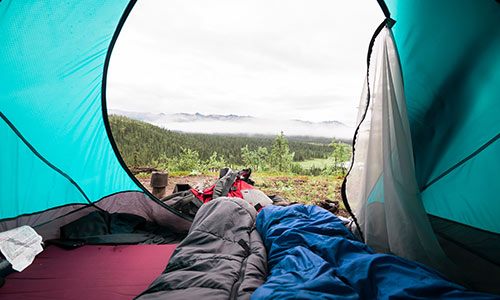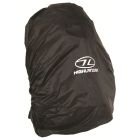Thriving Amidst Rain: Your Essential Guide to Wet-Weather Hiking
Author
As the saying goes, "Into each life, some rain must fall." For backpackers with the right mindset, rain can enhance the beauty of the wilderness, offering a crisper, cleaner, and calmer experience. However, hiking in heavy rainfall can also present unique challenges if you are unprepared. In this comprehensive guide, we will equip you with essential tips to thrive during wet-weather hikes. From adjusting your gear to mastering trail hazards, efficient campsite tactics, and effective drying methods, you will be well-prepared to embrace nature's serenity even in the rain.
Clothing Suggestions

Clothing Strategies:
- Bid farewell to cotton, as it doesn't wick sweat away and dries slowly, leading to potential hypothermia. Opt for moisture-wicking materials like wool, nylon, or polyester.
- Evaluate your rainwear, and choose a hard shell jacket for full waterproof protection. Consider renewing the Durable Water Repellent (DWR) coating on your rain gear to restore its performance.
Footwear:
- When facing cold conditions, waterproof boots keep your feet warm and dry. In milder weather, non-waterproof mesh shoes drain and dry quickly.
- Ensure your shoes have deep lug soles for traction on muddy trails and slippery rocks.
Pack Protection:
- Although packs may be made of waterproof material, their seams are often not sealed. Consider using a pack rain cover or pack liner to protect your gear from water.
Navigating Trail Hazards:
Slippery Surfaces:
- Exercise extra caution on muddy slopes, slimy rocks, and rain-slickened logs. Trekking poles provide stability and support on slippery terrain.
Swollen Creeks:
- Watch for fast-flowing, higher creeks, and unbuckle your hip belt before crossing, enabling you to escape your pack if you slip.
Flash Floods:
- Check weather forecasts in canyon areas and be prepared to seek higher ground swiftly.
Hypothermia:
- Recognize early symptoms, such as shivering and confusion. Opt for wool or synthetic clothing that retains insulation even when damp.
- Change into dry clothes when not hiking to maintain warmth.
Dehydration:
- Drink and eat regularly, even in the rain, to stay hydrated and energised on the trail.
Campsite Strategies:

Site Selection:
- Choose elevated, dry ground to reduce condensation inside your tent during colder temperatures.
- Seek shelter under trees to create a warmer microclimate with less condensation.
- Avoid camping beneath damaged tree limbs or trees that could pose hazards in storms.
- Steer clear of low-lying areas prone to water pooling during rain.
Pitching Tips:
- Practice setting up your tent at home to enhance efficiency in wet conditions.
- Use a footprint or extra plastic bags to shield your tent's base from moisture.
- Recruit help from fellow hikers or campers to hold the rainfly during setup.
- Prioritise a taut rainfly for better water resistance.
Drying Out Tricks:
Preserve Dry Clothes:
- Store a set of dry camp clothes in a waterproof bag to change into inside your tent.
- Consider changing into dry clothing during the day to maintain comfort and prevent hypothermia.
Seize Weather Windows:
- Utilise rain breaks to dry gear and clothing in sunlight. Use a utility cord as a makeshift clothesline for wet items.
- Extend your stay if needed to allow for full drying after a storm.
Dry Gear at Home:
- Ensure all gear is completely dry before storage to prevent mould and mildew growth.
Conclusion:
With proper preparation and the right gear, you can transform rainy hiking trips into unforgettable outdoor experiences. Embrace the serenity and magic of the wilderness amidst the rain, and let it enhance your connection with nature. Armed with the knowledge from this guide, you can confidently embark on wet-weather adventures, fully immersing yourself in the beauty of nature, regardless of the rain.
-
 Highlander Rucksack Lightweight Protective Cover£3.86RRP £8.50 Save Up To £4.64
Highlander Rucksack Lightweight Protective Cover£3.86RRP £8.50 Save Up To £4.64
Author
- Preventing Condensation Inside Your Tent: Tips for a Dry and Comfortable Camping Experience
- Effective Tips for Weight Loss Cycling: Achieve Your Goals and Stay Healthy
- Preparing for Hiking Snowdon: Embrace the Beauty of Snowdonia
- Find Your Way in The Dark Easily With These Great Night Navigation Guide
Categories
- Sport (28)
- Product Reviews (3)
- Team Outdoor Look (7)
- Mike Wild (2)
- Mike Payton (2)
- Suse Hammond-Pears (3)
- Snowboarding (12)
- Latest Offers (105)
- Shop Talk (1)
- Competitions (7)
- Walking (413)
- Lifestyle Fashion (8)
- Travel (86)
- Kit Guides (176)
- Workwear Clothing (6)
- Safety Workwear (4)
- Health/Fitness (289)
- Skiing (91)
- Great Outdoors (1316)
- Cycling (92)
- January 2025
- December 2024
- November 2024
- October 2024
- September 2024
- August 2024
- July 2024
- June 2024
- May 2024
- April 2024
- March 2024
- February 2024
- January 2024
- December 2023
- November 2023
- October 2023
- September 2023
- August 2023
- July 2023
- June 2023
- May 2023
- April 2023
- March 2023
- February 2023
- January 2023
- December 2022
- November 2022
- October 2022
- September 2022
- August 2022
- July 2022
- June 2022
- May 2022
- April 2022
- March 2022
- February 2022
- January 2022
- December 2021
- November 2021
- October 2021
- September 2021
- August 2021
- July 2021
- June 2021
- May 2021
- April 2021
- March 2021
- February 2021
- January 2021
- December 2020
- November 2020
- October 2020
- September 2020
- August 2020
- July 2020
- June 2020
- May 2020
- April 2020
- March 2020
- February 2020
- January 2020
- December 2019
- November 2019
- October 2019
- September 2019
- August 2019
- July 2019
- June 2019
- May 2019
- April 2019
- March 2019
- February 2019
- January 2019
- December 2018
- November 2018
- October 2018
- September 2018
- August 2018
- July 2018
- June 2018
- May 2018
- April 2018
- March 2018
- February 2018
- January 2018
- December 2017
- November 2017
- October 2017
- September 2017
- August 2017
- July 2017
- June 2017
- May 2017
- April 2017
- March 2017
- February 2017
- January 2017
- December 2016
- November 2016
- October 2016
- September 2016
- August 2016
- July 2016
- June 2016
- May 2016
- April 2016
- March 2016
- February 2016
- January 2016
- December 2015
- November 2015
- October 2015
- September 2015
- August 2015
- July 2015
- June 2015
- May 2015
- April 2015
- March 2015
- February 2015
- January 2015
- December 2014
- November 2014
- October 2014
- September 2014
- August 2014
- July 2014
- June 2014
- May 2014
- April 2014
- March 2014
- February 2014
- January 2014
- December 2013
- November 2013
- October 2013
- September 2013
- August 2013
- July 2013
- June 2013
- May 2013
- April 2013
- March 2013
- February 2013
- January 2013
- December 2012
- November 2012
- October 2012
- September 2012
- August 2012
- July 2012
- June 2012
- May 2012
- April 2012
- March 2012
- February 2012
- January 2012
- December 2011
- November 2011
- October 2011
- September 2011
- August 2011
- May 2010
- April 2010
- March 2010
- February 2010
- January 2010
- November 2009
- October 2009
- September 2009


Submit a Comment